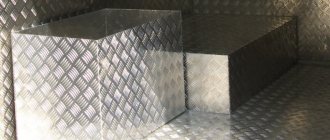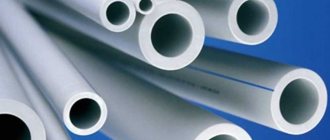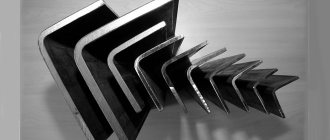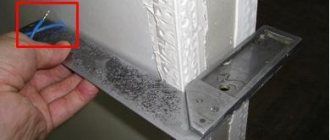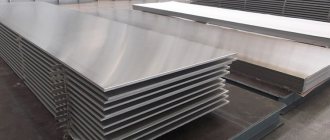The main activity of the Perfosklad enterprise in Russia is the production of high-quality metal perforated sheets. We produce sheets of different types, sizes and thicknesses.
It is possible to produce material to order according to individual parameters.
Perforated materials in buildings
Perforated materials are widely used in construction and architecture for both decorative and functional purposes.
They create more comfortable conditions inside the building, provide natural ventilation and daylighting, and protect from direct sunlight. Perforated panels also serve to increase the safety of the building and create the desired acoustic characteristics of the building (Figures 1 and 2). Figure 1 – Perforated sheets in building cladding
Figure 2 – Sun protection made from perforated materials
Perforated metal sheets are also widely used in the manufacture of suspended ceilings [2] (Figure 3).
Figure 3 – Suspended ceiling made of perforated materials
Perforated sheet made to order is used:
- Mechanical engineering.
- Agriculture. Sieves and sieves for grain separation (processing);
- Chemical, oil refining industry. Air vents and filters are made from perforated steel sheet;
- Design. Used as design elements for outdoor advertising
- Electrics. Stainless steel products and galvanized perforated sheets are used to complete electrical cabinets with power equipment;
- Food production. Used for making baking trays for baking bread, trays for frying, sauteing, freezing
- Trade and exhibition equipment, household and office furniture. Information stands, shelving, wall panels, bar counters, furniture components, etc.
We deliver production of perforated metal sheets to the cities: Moscow, St. Petersburg, Novosibirsk, Yekaterinburg, Kazan, Nizhny Novgorod, Chelyabinsk, Samara, Omsk, Rostov-on-Don, Ufa, Krasnoyarsk, Voronezh, Perm, Volgograd, Krasnodar, Saratov, Tyumen , Togliatti, Izhevsk, Barnaul, Ulyanovsk, Irkutsk, Khabarovsk, Yaroslavl, Vladivostok, Makhachkala, Tomsk, Orenburg, Kemerovo, Novokuznetsk, Ryazan, Naberezhnye Chelny, Astrakhan, Penza, Kirov, Lipetsk, Balashikha, Cheboksary, Kaliningrad, Tula, Kursk, Stavropol, Sochi, Ulan-Ude, Tver, Magnitogorsk, Ivanovo, Bryansk, Belgorod, Surgut, Vladimir, Chita, Arkhangelsk, Crimea, Kaluga, Smolensk, Volzhsky, Yakutsk, Saransk, Cherepovets, Kurgan, Vologda, Orel, Podolsk, Grozny, Vladikavkaz, Tambov, Murmansk, Petrozavodsk, Nizhnevartovsk, Kostroma, Sterlitamak, Novorossiysk, Yoshkar-Ola, Khimki, Taganrog, Komsomolsk-on-Amur, Syktyvkar, Nizhnekamsk, Nalchik, Mytishchi, Shakhty, Dzerzhinsk, Engels, Orsk, Blagoveshchensk, Bratsk, Korolev, Angarsk, Stary Oskol, Pskov, Lyubertsy, Yuzhno-Sakhalinsk, Biysk, Armavir, Prokopyevsk, Balakovo, Abakan, Rybinsk, Severodvinsk, Norilsk, Petropavlovsk-Kamchatsky, Krasnogorsk, Ussuriysk, Volgodonsk, Novocherkassk, Syzran, Kamensk-Uralsky, Zlatoust , Almetyevsk, Elektrostal, Kerch, Miass, Salavat, Pyatigorsk, Kopeisk, Nakhodka, Khasavyurt, Rubtsovsk, Maykop, Kolomna, Berezniki, Domodedovo, Kovrov, Odintsovo, Neftekamsk, Kislovodsk, Bataysk, Nefteyugansk, Novocheboksarsk, Serpukhov, Shchelkovo, Derbent, Kaspiysk , Cherkessk, Novomoskovsk, Nazran, Ramenskoye, Pervouralsk, Kyzyl, Orekhovo-Zuevo, Novy Urengoy, Obninsk, Nevinnomyssk, Dolgoprudny, Oktyabrsky, Dimitrovgrad, Essentuki, Kamyshin, Evpatoria, Sevastopol, Simferopol, Reutov, Zhukovsky, Pushkino, Murom, Noyabrsk, Novoshakhtinsk, Seversk, Artyom, Achinsk, Berdsk, Noginsk, Arzamas, Elista, Yelets, Khanty-Mansiysk, Novokuibyshevsk, Zheleznogorsk, Sergiev Posad, Zelenodolsk
Materials for perforated sheets
Perforated metal materials have great potential for use in construction. The strength characteristics of perforated materials make it possible for them to be fully used in building structures. The main materials for the manufacture of perforated building elements are steel, aluminum and copper. Aluminum and copper sheet materials are used in building structures due to their high corrosion resistance and architectural attractiveness, and perforated steel sheets are used due to their high strength.
Aluminum alloys are lightweight, have fairly high strength and are easily perforated. Copper is widely used as a roofing material. The oxide layer - patina - on the surface of copper provides copper materials with high corrosion resistance and, therefore, high durability. Copper sheets also lend themselves well to perforation and, in addition, are well welded. However, perforated steel materials are the most widely used in construction due to their high strength and lower cost [1].
Punched sheets: a practical material for your construction
Metal sheets with perforations applied to them are widely used in finishing, construction and manufacturing.
They can be found as a fence or fence, decorative wall panels or mobile structures; they are indispensable in the production of warehouse and industrial furniture. You can buy perforated sheets made of steel (both galvanized and stainless), as well as aluminum. The thickness, size and type of perforation can be selected in the catalog, or ordered according to your parameters.
Shape of perforated holes
The shape of the holes can have a wide variety of shapes: round, square, rectangular, oval, elliptical, rhombic [2]. At the same time, it is known that perforated products with round holes make up about 80% of all perforated products. This hole shape is most suitable for all applications of perforated materials. Round holes are the most convenient to manufacture and require minimal costs compared to other hole shapes. Dies and punches for round holes are the most economical and convenient for equipment maintenance.
Minimum hole size
The minimum perforated hole size depends on the type of material and its thickness. The rule of thumb for steel and aluminum sheets is that the diameter of the round hole should be at least as large as the thickness of the material. The closer the ratio of hole diameter and material thickness approaches to 1:1, the higher the likelihood of tool failure and the cost of maintaining it in working order and, therefore, the cost of perforated products. For the manufacture of perforated sheets from stainless steels and other high-strength materials, sheets with a thickness one size thinner than the diameter of the hole are usually used.
For example, in suspended ceilings, galvanized steel sheets 0.6 mm thick with a minimum hole diameter of 0.7 mm and aluminum sheets 0.8 mm thick with a minimum hole diameter of 0.7 mm are used [2].
Aluminum and steel perforated sheets: prices and benefits
In the manufacture of this material, the metal retains its original strength and flexibility, losing a significant part of its weight. That is why it is often used where high reliability with minimal load is important.
The price of perforated sheet depends on the metal used as raw material. Each of them has its own advantages.
- Aluminum is a lightweight and very flexible metal. It is easy to process and easy to transport and install. Sheets made from it do not oxidize and do not lose their functional qualities. Aluminum is used for cladding buildings and the construction of temporary mobile structures.
- Galvanized steel is durable and at the same time resistant to corrosion due to the thin zinc layer. It is often used to create shelving and fences. To make the finished galvanized product look aesthetically pleasing, it is often painted.
- Stainless steel - the addition of chromium preserves the strength of the metal and its glossy shine, and therefore is used in finishing even without a decorative coating. Chrome protects iron from corrosion and significantly extends its service life.
You can also buy perforated steel sheets made by cold or hot rolling.
Perforation percentage
The percentage of perforation is a very important parameter that determines the level of strength properties of a perforated structure compared to a similar structure made from a material without perforation. Examples of metal sheets with different percentages of perforation are shown in Figure 4.
Figure 4 – View of different percentages of perforation (48%, 37% and 23%)
Standard round perforation
Standard perforation has the form of round holes, which are located in the corners of the grid of equilateral triangles (at an angle of 60º), as shown in Figure 5. About half of all perforated sheets have this appearance.
Figure 5 – Perforated sheet with round holes at an angle of 60º [2]
Standard sizes of punched sheets
Perforated metal sheet with perforation is a high-tech material that has a fairly wide range of uses. Visually, it is a rather light and openwork, thin sheet of metal, but at the same time it is quite practical, reliable, strong and durable.
Because of its technical capabilities, the material is loved by designers, constructors and architects. With its help, incredible things and products that have no analogues are created. Such sheets are produced from different types of steel, aluminum and its alloys on special CNC machines.
Standard dimensions of perforated sheet are 1000×2000 mm, 1250×2500 mm or 1500×3000 mm, and the thickness of the product differs depending on the type of metal used:
- Stainless steel - 0.8 - 2.0 millimeters.
- Galvanized steel - 0.7 - 2.0 millimeters.
- Aluminum and alloys - 0.8 - 2.0 millimeters.
Strength properties of perforated sheet
As the proportion of perforation increases, the strength properties of the perforated sheet decrease. Figure 6 shows the change in yield strength of a perforated material with standard round perforations as the perforation fraction increases. A perforated sheet can have different strength in its plane depending on the direction of load along the width or length of the sheet [1, 3].
Figure 6 – Reduction in the yield strength of a standard perforated sheet (in the plane of the sheet) with an increase in the proportion of perforation [1, 3]:
fy*—yield strength of perforated sheet;
fy—yield strength of sheet without perforation
Elastic properties of perforated sheet
With an increase in the proportion of perforation, the elastic modulus of perforated materials decreases quite sharply, and the Poisson’s ratio increases [1, 3] (Figure 7).
Figure 7 – Effective elastic properties of a standard perforated sheet (in the plane of the sheet) depending on the percentage of perforation [1, 3]:
E*—modulus of elasticity of the perforated sheet;
E – elastic modulus of the sheet before perforation;
ν*—Poisson’s ratio of perforated sheet;
ν — Poisson’s ratio of the sheet before perforation
Our capabilities for producing punched sheets
- Perforated galvanized sheet, made of stainless, black steel, aluminum with various types of perforation up to 10 mm thick;
- Perforated metal sheet of standard sizes: 1000x2000 mm, 1250x2500 mm, 1500x3000 mm;
- Manufactured according to customer drawings, taking into account the maximum sheet dimensions: width - 1500 mm, length - 3000 mm. If the maximum sheet length is more than 3000 mm, the perforated sheet is supplied in rolls;
- Round (Rv, Rg, Rd), square (Qv, Qg, Qd), rectangular (Lve, Lge), oblong (Lvl, Lgl, Ldl), decorative perforation;
- Products made from perforated sheets (sieves, filters);

